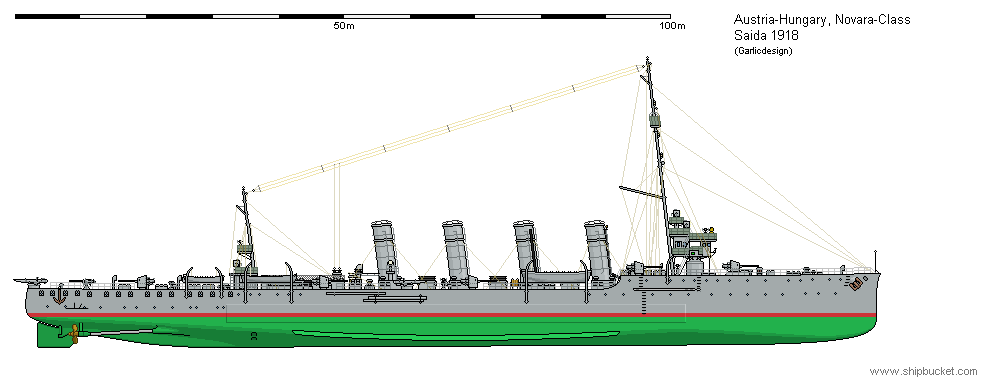RM Venezia: sunk at moorings Mogadishu, 1941
As part of the triumphant Allied nations, Italy received her share of the surrendered Austro-Hungarian naval ships. This amounted to two Austro-Hungarian cruisers of the Novara class.
The two Austro-Hungarian cruisers Helgoland and Saida of the Novara class, became the Brindisi and Venezia. The two cruisers were transferred to the Italian Navy in 1919, but did not enter Italian service till 1923 after a period in Italian dockyard hands, to increase their suitability for overseas service. These two cruisers were to spend their time in Italian East African waters. Originally chasing pirates and doing contraband checks, then after another period in dockyard hands, acting as anti-aircraft cruisers.

Above, the two Novara class ships were received in this condition with the low angle 3.9" as main armament, the 66mm AA gun aft of the aft 3.9", and three twin 21" torpedo tubes. To make the ships ready for service in Italian East Africa, the two ships were fitted air conditioning and fans to move the air around the ship in the stifling conditions around the Equatorial regions. The very aft torpedo tubes were removed and the centre 3.9" were replaced with two more Italian AA guns (as was the 66mm gun). The ship went to war with the pirates of East Africa with seven 3.9" guns, three 76mm AA guns, and four 21" torpedo tubes.
.png)
1934 and that 20 year itch comes along. Do the Italians scratch it, and scrap the ships? The question is, "what do we replace them with?". Being non-Italian ships they are not as well liked as the home grown ships. But, and it is a big but, the Italians did not build any light or heavy cruisers for 20 years. The Italian Navy was very short of those such vessels, which is why the German and A-H cruisers survive so long. There is nothing else like them in the Italian Navy. It was decided that the two Novara class cruisers would get a refresh using the same sized 3.9" weapons already fitted but the new weapons would be dual purpose. The boilers would finally be changed from coal firing to oil firing. The funnels would be reduced from four to two (trunked together). A modern bridge structure would be fitted that would mount the new dual purpose fire control system. Modern fast firing AA canons would also be fitted.
.png)
The two boats in the middle of the ship, were armed with a heavy machine gun, for chasing pirates into bays and rivers the ship could not enter, these could be replaced with small landing craft, depending on the ships mission. The ships finest hour was sneaking up to Diego Garcia, landing 160 raiders that destroyed the defences of the airfield and harbour, allowing two of the battle raiders to bombard and destroy the port facilities. Both groups returning to harbour without interception. Both ships are eventually sunk at their moorings by air attack. They were a priority target due to the AA defence they provided to the harbour and fire support to the defending troops.
